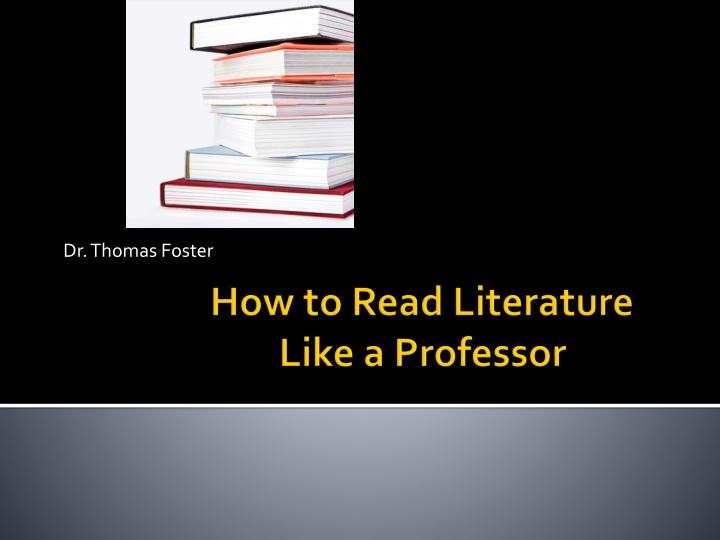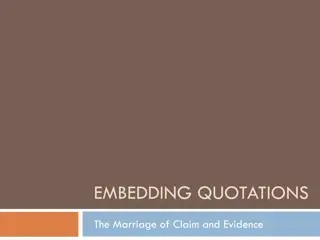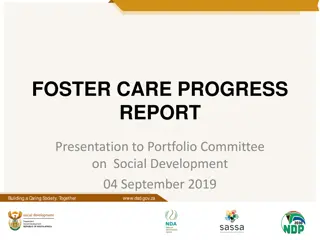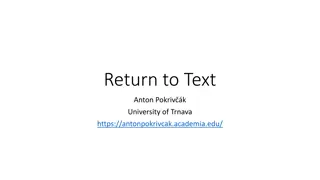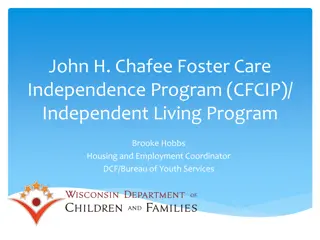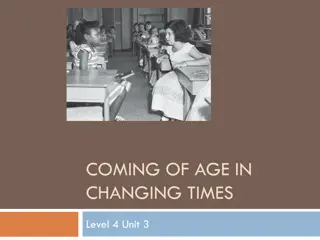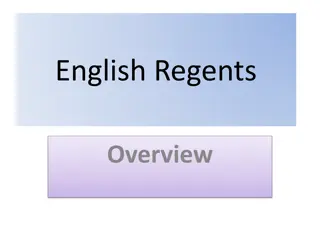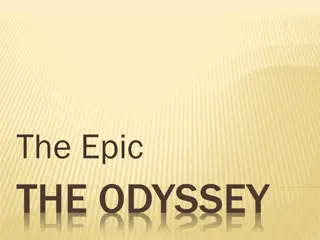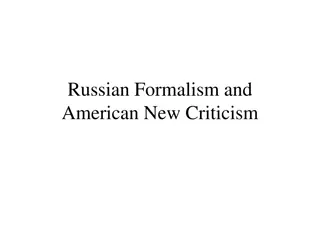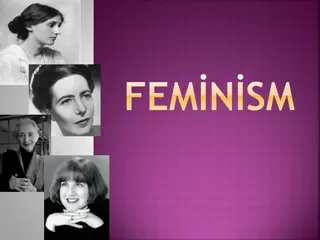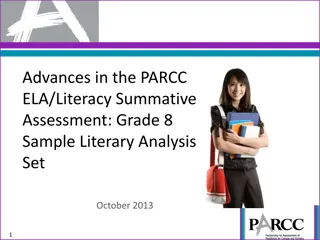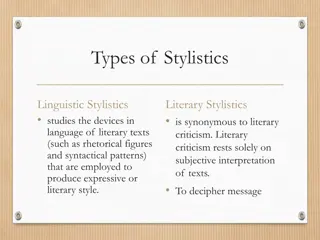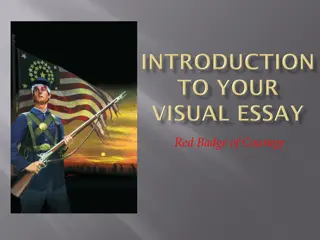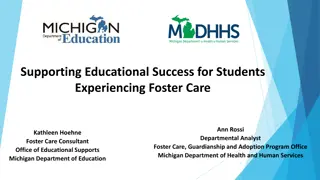Literary Analysis Insights by Dr. Thomas Foster
Uncover insightful perspectives on literary themes such as quests, communion, vampirism, intertextuality, and common cultural references like Shakespeare and Biblical stories. Dr. Thomas Foster delves deep into the layers of meaning and connections within literature, shedding light on familiar tropes and their significance in storytelling.
Download Presentation

Please find below an Image/Link to download the presentation.
The content on the website is provided AS IS for your information and personal use only. It may not be sold, licensed, or shared on other websites without obtaining consent from the author.If you encounter any issues during the download, it is possible that the publisher has removed the file from their server.
You are allowed to download the files provided on this website for personal or commercial use, subject to the condition that they are used lawfully. All files are the property of their respective owners.
The content on the website is provided AS IS for your information and personal use only. It may not be sold, licensed, or shared on other websites without obtaining consent from the author.
E N D
Presentation Transcript
a. A quester b. A place to go c. A stated reason to go there d. Challenges and trials e. The real reason to go is never for the stated reason; the quester usually fails at the stated task; The real reason is educational always self-knowledge
a. Whenever people eat or drink together, it s communion b. Not usually religious c. An act of sharing and peace d. A failed meal carries negative connotations (a bad sign!)
a. Literal Vampirism: Nasty old man, attractive but evil, violates a young woman, leaves his mark, takes her innocence b. Sexual implications a trait of 19th century literature to address sex indirectly c. Symbolic Vampirism: selfishness, exploitation, refusal to respect the autonomy of other people, using people to get what we want, placing our desires, particularly ugly ones, above the needs of another.
a. There is no such thing as a wholly original work of literature stories grow out of other stories, poems out of other poems. b. There is only one story of humanity and human nature, endlessly repeated c. Intertexuality recognizing the connections between one story and another deepens our appreciation and experience, brings multiple layers of meaning to the text, which we may not be conscious of. The more consciously aware we are, the more alive the text becomes to us. d. If you don t recognize the correspondences, it s ok. If a story is no good, being based on Hamlet won t save it.
Writers use what is common in a culture as a kind of shorthand. Shakespeare is pervasive, so he is frequently echoed. b. See plays as a pattern, either in plot or theme or both. Examples: i. Hamlet: heroic character, revenge, indecision, melancholy nature ii. Henry IV a young man who must grow up to become king, take on his responsibilities iii. Othello jealousy iv. Merchant of Venice justice vs. mercy v. King Lear aging parent, greedy children, a wise fool
a. Before the mid 20th century, writers could count on people being very familiar with Biblical stories, a common touchstone a writer can tap. b. Common Biblical stories with symbolic implications: Garden of Eden: women tempting men and causing their fall, the apple as symbolic of an object of temptation, a serpent who tempts men to do evil, and a fall from innocence David and Goliath overcoming overwhelming odds Jonah and the Whale refusing to face a task and being eaten or overwhelmed by it anyway. Job: facing disasters not of the character s making and not the character s fault, suffers as a result, but remains steadfast.
The Flood: rain as a form of destruction; rainbow as a promise ofrestoration Christ figures (a later chapter): in 20th century, often used ironically The Apocalypse Four Horseman of the Apocalypse usher in the end of the world. Biblical names often draw a connection between literary character and Biblical character.
a. Hansel and Gretel: lost children trying to find their way home b. Peter Pan: refusing to grow up, lost boys, a girl-nurturer/ c. Little Red Riding Hood: See Vampires d. Alice in Wonderland, The Wizard of Oz: entering a world that doesn t work rationally or operates under different rules, the Red Queen, the White Rabbit, the Cheshire Cat, the Wicked Witch of the West, the Wizard, who is a fraud e. Cinderella: orphaned girl abused by adopted family saved through supernatural intervention and by marrying a prince
f. Snow White: Evil woman who brings death to an innocent again, saved by heroic/princely character g. Sleeping Beauty: a girl becoming a woman, symbolically, the needle, blood=womanhood, the long sleep an avoidance of growing up and becoming a married woman, saved by, guess who, a prince who fights evil on her behalf. h. Evil Stepmothers, Queens, Rumpelstilskin i. Prince Charming heroes who rescue women. (20th c. frequently switched the women save the men or used highly ironically)
a. Myth is a body of story that mattersthe patterns present in mythology run deeply in the human psyche b. Why writers echo myth because there s only one story (see #4) c. Odyssey and Iliad i. Men in an epic struggle over a woman ii. Achilles a small weakness in a strong man; the need to maintain one s dignity iii. Penelope (Odysseus s wife) the determination to remain faithful andto have faith
iv. Hector: The need to protect ones family d. The Underworld an ultimate challenge, facing the darkest parts of human nature or dealing with death e. Metamorphoses by Ovid transformation (Kafka) f. Oedipus: family triangles, being blinded, dysfunctional family g. Cassandra: refusing to hear the truth h. A wronged woman gone violent in her grief and madness Aeneas and Didoor Jason and Medea i. Mother love Demeter and Persephone
a. Rain = fertility and life ii. Noah and the flood iii. Drowning one of our deepest fears b. Why? i. plot device ii. Atmospheric iii. misery factor challenge characters iv. democratic element the rain falls on the just and the unjust alike c. Symbolically i. rain is clean a form of purification, baptism, removing sin or a stain ii. rain is restorative can bring a dying earth back to life iii. destructive as well causes pneumonia, colds, etc.; hurricanes, etc. iv. Ironic use April is the cruelest month (T.S. Eliot, The Wasteland)
v. RainbowGods promise never to destroy the world again; hope; a promise of peace between heaven and earth vi. fog almost always signals some sort of confusion; mental, ethical, physical fog ; people can t see clearly d. Snow i. negatively cold, stark, inhospitable, inhuman, nothingness, death ii. positively clean, pure, playful iii great unifier= snow falls on all- living and dead.
a. Violence can be symbolic, thematic, biblical, Shakespearean, Romantic, allegorical, transcendent. b. Two categories of violence in literature: i. Character caused shootings, stabbings, drownings, poisonings, bombings, hit and run, etc ii. Death and suffering for which the characters are not responsible. Accidents are not really accidents.
c. Violence is symbolic action, but hard to generalize meaning d. Questions to ask: i. What does this type of misfortune represent thematically? ii. What famous or mythic death does this one resemble? iii. Why this sort of violence and not some other?
a. Yes. But figuring out what is tricky. Can only discuss possible meanings and interpretations b. There is no one definite meaning unless it s an allegory, where characters, events, places have a one-on-one correspondence symbolically to other things. (Animal Farm) c. Actions, as well as objects and images, can be symbolic. i.e. The Road Not Taken by Robert Frost d. How to figure it out? Symbols are built on associations readers have, but also on emotional reactions. Pay attention to how you feel about a text.
a. Literature tends to be written by people interested in the problems of the world, so most works have a political element in them b. Issues: i. Individualism and self-determination against the needs of society for conformity and stability. ii. Power structures iii. Relations among classes iv. issues of justice and rights v. interactions between the sexes and among various racial and ethnic constituencies.
a. Characteristics of a Christ Figure: i. crucified, wounds in hands, feet, side, and head, often portrayed with arms outstretched ii. in agony iii. self-sacrificing iv. good with children v.. good with loaves, fishes, water, wine vi. thirty-three years of age when last seen
vii. employed as a carpenter viii. known to use humble modes of transportation, feet or donkeys preferred ix. believed to have walked on water x. known to have spent time alone in the wilderness xi. believed to have had a confrontation with the devil, possibly tempted xii. last seen in the company of thieves xiii. creator of many aphorisms and parables xiv. buried, but arose on the third day xv. had disciples, twelve at first, although not all equally devoted xvi. very forgiving xvii. came to redeem an unworthy world
b. As a reader, put aside belief system. c. Why use Christ figures? Deepens our sense of a character s sacrifice, thematically has to do with redemption, hope, or miracles. d. If used ironically, makes the character look smaller rather than greater
a. Daedulus and Icarus b. Flying was one of the temptations of Christ c. Symbolically: freedom, escape, the flight of the imagination, spirituality, return home, largeness of spirit, love d. Interrupted flight generally a bad thing e. Usually not literal flying, but might use images of flying, birds, etc. f. Irony trumps everything
a. Female symbols: chalice, Holy Grail, bowls, rolling landscape, empty vessels waiting to be filled, tunnels, images of fertility b. Male symbols: blade, tall buildings c. Why? i. Before mid 20th c., coded sex avoided censorship ii. Can function on multiple levels iii. Can be more intense than literal descriptions
When authors write directly about sex, they re writing about something else, such as sacrifice, submission, rebellion, supplication, domination, enlightenment, etc.
a. Baptism is symbolic death and rebirth as a new individual b. Drowning is symbolic baptism, IF the character comes back up, symbolically reborn. But drowning on purpose can also represent a form of rebirth, a choosing to enter a new, different life, leaving an old one behind. c. Traveling on water rivers, oceans can symbolically represent baptism. i.e. young man sails away from a known world, dies out of one existence, and comes back a new person, hence reborn
Rivers can also represent the River Styx, the mythological river separating the world from the Underworld, another form of transformation, passing from life into death. d. Rain can by symbolic baptism as well cleanses, washed e. Sometimes the water is symbolic too the prairie has been compared to an ocean, walking in a blizzard across snow like walking on water, crossing a river from one existence to another (Beloved) f. There s also rebirth/baptism implied when a character is renamed.
a. What represents home, family, love, security? b. What represents wilderness, danger, confusion? i.e. tunnels, labyrinths, jungles c. Geography can represent the human psyche (Heart of Darkness) d. Going south=running amok and running amok means having a direct, raw encounter with the subconscious. e. Low places: swamps, crowds, fog, darkness, fields, heat, unpleasantness, people, life, death f. High places: snow, ice, purity, thin air, clear views, isolation, life, death
a. Spring, Summer, Fall, Winter=youth, adulthood, middle age, old age/death. b. Spring=fertility, life, happiness, growth, resurrection (Easter) c. Fall=harvest, reaping what we sow, both rewards and punishments d. Winter=hibernation, lack of growth, death, punishment e. Christmas=childhood, birth, hope, family f. Irony trumps all April is the cruelest month from The Wasteland
a. Physical marks or imperfections symbolically mirror moral, emotional, or psychological scars or imperfections. b. Landscapes can be marked as well The Wasteland by T.S. Eliot c. Physical imperfection, when caused by social imperfection, often reflects not only the damage inside the individual, but what is wrong with the culture that causes such damage
d. Monsters i. Frankenstein monsters created through no fault of their own; the real monster is the maker ii. Faust bargains with the devil in exchange for one s soul iii. Dr. Jekyll and Mr. Hyde the dual nature of humanity, that in each of us, no matter how well-made or socially groomed, a monstrous Other exists. iv. Quasimodo, Beauty and the Beast ugly on the outside, beautiful on the inside. The physical deformity reflects the opposite of the truth.
a. Physical blindness mirrors psychological, moral, intellectual (etc.) blindness b. Sometimes ironic; the blind see and sighted are blind c. Many times blindness is metaphorical, a failure to see reality, love, truth, etc. d. darkness=blindness; light=sight
a. Heart disease=bad love, loneliness, cruelty, disloyalty, cowardice, lack of determination. b. Socially, something on a larger scale or something seriously amiss at the heart of things (Heart of Darkness)
a. Not all illnesses are created equal. Tuberculosis occurs frequently; cholera does not because of the reasons below b. It should be picturesque c. It should be mysterious in origin d. It should have strong symbolic or metaphorical possibilities
i. Tuberculosisa wasting disease ii. Physical paralysis can mirror moral, social, spiritual, intellectual, political paralysis iii. Plague: divine wrath; the communal aspect and philosophical possibilities of suffering on a large scale; the isolation an despair created by wholesale destruction; the puniness of humanity in the face of an indifferent natural world iv. Malaria: means literally bad air with the attendant metaphorical possibilities.
v. Venereal disease: reflects immorality OR innocence, when the innocent suffer because of another s immorality; passed on to a spouse or baby, men s exploitation of women vi. AIDS: the modern plague. Tendency to lie dormant for years, victims unknowing carriers of death, disproportionately hits young people, poor, etc. An opportunity to show courage and resilience and compassion (or lack of); political and religious angles vii. The generic fever that carries off a child
a. You must enter the reality of the book; dont read from your own fixed position in 2008. Find a reading perspective that allows for sympathy with the historical movement of the story, that understands the text as having been written against its own social, historical, cultural, and personal background. b. We don t have to accept the values of another culture to sympathetically step into a story and recognize the universal qualities present there.
a. Irony trumps everything. Look for it. b. Example: Waiting for Godot journeys, quests, self-knowledge turned on its head. Two men by the side of a road they never take and which never brings anything interesting their way. c. Irony doesn t work for everyone. Difficult to warm to, hard for some to recognize which causes all sorts of problems. Satanic Verses
